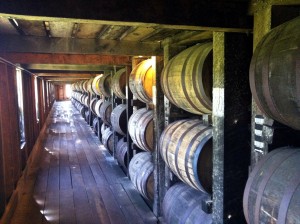A NEW BARREL IS BORN
Whiskey barrels are built from American white oak, wood used exclusively because of its strength and tight grain. Trees selected are cut during autumn or winter when sap is low, then sawn into staves of varying widths and seasoned by drying in open air from six months to two years.
After aging, staves are planed to a thickness of one inch and milled to give them a double taper on each end. A cooper begins building a barrel by setting alternately wide and narrow staves on end within an iron hoop. Once sufficient staves have been tightly fit together, about 33 of them usually, the cooper ties the upper ends of the staves with a loop and sends the construction through a steam tunnel. Staves absorb moisture and become more flexible, then a machine draws the open end together. Temporary iron hoops are placed on both ends and two more hoops are forced toward the barrel’s center to squeeze staves into the traditional barrel shape.
Barrels then pass over gas burners which burn the inside to one of seven levels of charring specified by the distiller. Water sprayed on the inside and outside makes the staves more flexible and keeps them from charring too quickly. Five or six straight staves are fitted together with wooden dowels then cut circular to make the barrel heads. These are also charred on one side.
Barrel ends are notched, temporary end hoops are removed, barrel heads are fitted into the notches, and permanent iron bands are placed on the barrel ends. Body hoops are also removed and replaced with stronger iron bands and a bung hole is drilled into one of the wider staves. After the barrel is sanded smooth it is pressure-tested with water and air to make sure it doesn’t leak. The finished barrel, which weighs 110 pounds and holds 53 gallons, is then shipped to the distillery.
ITS MISSION IN LIFE
 A whiskey barrel’s purpose is to hold about 50 gallons of a distiller’s product and provide an environment for it to age. Now weighing about 500 pounds, the barrel is stored on a rack in a barrelhouse. Racks are loaded from both sides of the building and barrels are rolled to the center. In a procedure called “clocking,” each barrel is positioned so when it rolls to meet those already on the rack the bung plug will be facing up and won’t leak or be forced out by the weight of the contents.
A whiskey barrel’s purpose is to hold about 50 gallons of a distiller’s product and provide an environment for it to age. Now weighing about 500 pounds, the barrel is stored on a rack in a barrelhouse. Racks are loaded from both sides of the building and barrels are rolled to the center. In a procedure called “clocking,” each barrel is positioned so when it rolls to meet those already on the rack the bung plug will be facing up and won’t leak or be forced out by the weight of the contents.
The barrel’s contents age at least two years but often up to twenty or more years, continually passing in and out of charred wood cells as external temperatures rise and fall. The wood provides the amber color and flavors of caramel and vanilla, among others, to what in time will be whiskey.
Some distilleries have one-story barrelhouses and all barrels age at the same seasonal range of temperatures. Other distilleries have multi-story barrelhouses and temperatures in the upper floors vary more than those in the lower. Whiskey from higher floors will thus taste different than whiskey from the lower. Some distillers rotate barrels between floors so everything tastes the same; other distillers do not rotate barrels and market the varied results as different products.
A BARREL RETIRES TO TOUR THE WORLD
By law, bourbon barrels cannot be reused to make bourbon, but can be used again in the US to age brandy or other forms of whiskey. Distillers in Canada, Scotland, and Ireland import bourbon barrels to use along with port and sherry casks as part of their products’ aging processes. This prolongs a barrel’s useful life by another ten to twenty years. By the time an old whiskey barrel finds its way to a greenhouse or lumber yard and comes to rest as a flower planter in your front yard, be aware it may be older and have seen more of the world than you.
